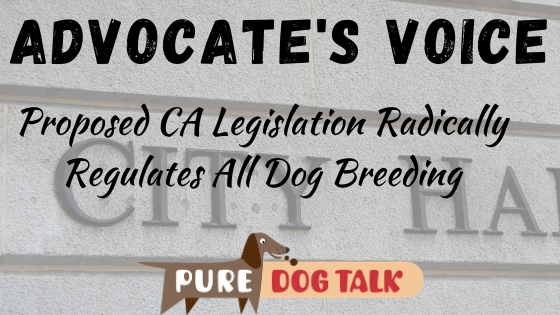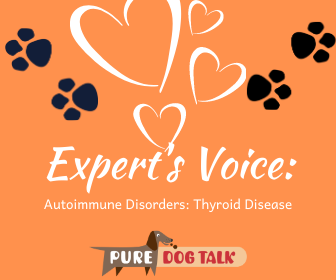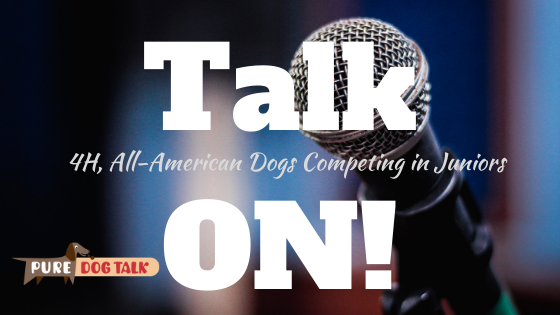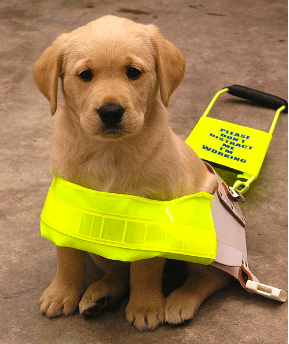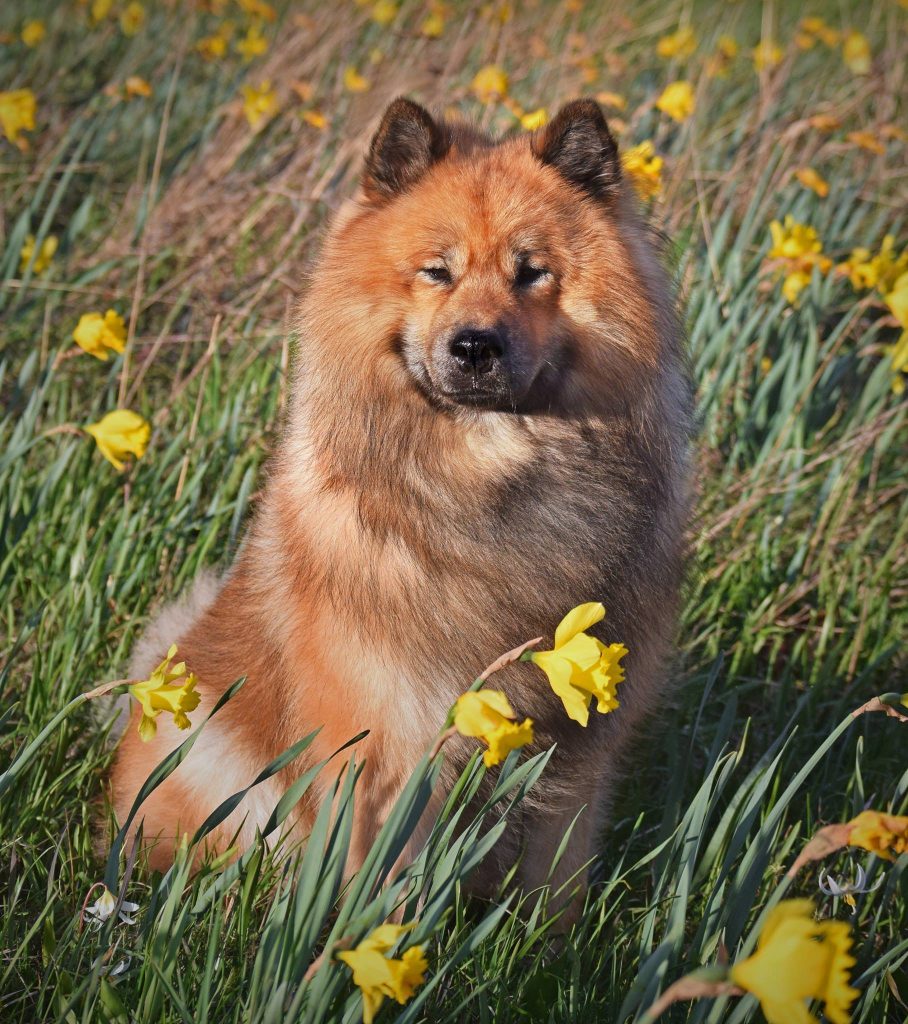Posts by Laura Reeves
468 – Bloat 911: Know the Signs, Be Prepared
Bloat 911: Know the Signs, Be Prepared
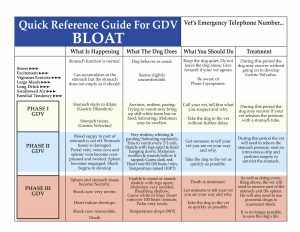
PRINT this chart for reference in your dogs’ area.
Dr. Marty Greer, DVM joins host Laura Reeves for a primer on one of the most terrifying and emergent situations we can encounter with our dogs – bloat. Most noted in large and giant breeds of middle to advanced age, Greer notes that small dogs and puppies are not immune.
“There are parts of this that no one still understands,” Greer said, “even though we’ve known about gastric dilatation volvulus, GDV or bloat, for decades and decades. I mean, when I was in veterinary school, it was a big deal. Unfortunately, we have still a lot of holes in the knowledge we have about it.
What happens
“Essentially what happens is the stomach fills with fluid, air, food, different materials and in gastric dilatation it dilates. In gastric dilatation volvulus it dilates and then rotates inside the abdomen.
“It can be one or both. The distinguishing feature is going to be available only by X Ray. Just looking at a dog at a dog show or in your hotel room or at your house and your kennel, in the veterinary lobby, you can’t tell the difference between a volvulus and a dilatation. So, an X Ray is needed to determine what’s going on.
Why it happens
“(When) material starts to fill the stomach and it starts to dilate, there’s some kind of an outflow obstruction, which is not clearly identified, which keeps the fluid and gas from being able to go down into the small intestine. The stomach dilates further and further and further …gas is produced either by fermentation or by gulping air.
“The dogs typically will attempt to vomit, but are unproductive in their efforts …That’s probably the one distinguishing thing that you can determine when you’re looking at a dog, as the abdomen is distended… if they’re able to productively vomit, food is coming up, fluid is coming up, it’s probably not a boat. If their efforts to vomit are unproductive, you have a genuine life crisis medical emergency on your hands and you cannot get to a veterinary clinic for care fast enough.
“The problem is this becomes this really vicious cycle of metabolic and respiratory and circulatory disasters that just feed on each other. As soon as the stomach starts to fill with gas, the dog develops acidosis. They can’t produce any vomit. The stomach starts to press on the diaphragm, so they can’t breathe adequately. And then their circulation starts to slow down because there’s pressure on the vena cava.
“There are all these metabolic cascades that start to happen that become a vicious cycle. One makes the next part worse, which makes the next worse, which makes the next worse. Which is why the dogs decompensate and die of shock or ruptured stomach or cardiac malfunctions.
What can you do?
“There are some correlations that people have made with the time of eating and the amount of exercise afterwards, but there’s not a strong correlation. You can follow every single guideline that you possibly have ever read about to try and reduce the risk of it. And it can still happen anyway. That’s what’s really devastating about it … You feel really helpless because you can’t prevent it and you can’t predict it. And when it happens, it doesn’t matter what time of the day it is. You need immediate medical care. Half an hour ago.
“(The stomach is noticeably distended)… it can sound like a watermelon when you thump it… so if there’s any possibility, a little inkling that something is not right, if a dog is restless, won’t lay down, won’t eat, won’t drink, and it’s really non-productively trying to vomit, you go get an X Ray. Period, end of discussion.
“You call the emergency clinic on your way. You tell them what you have for a breed, the circumstances and you say I’m coming in for an X Ray. And you hope to God that there’s not six other really serious medical emergencies ahead of yours so that you can get the immediate attention that’s required.
“If you have the option of going to two different practices, you’ll probably want to call ahead and see who can accommodate you when you arrive, because there is no sitting in the parking lot and waiting. There is no calling in the surgeon. There is no ‘we’ll get around to you when we get around to you.’ It is right now.”
Listen to the rest of our conversation to learn about passing a stomach tube to give the dog more time, prophylactically tacking the stomach, potential genetic predisposition that can impact breeding decisions and more.
Listen HERE for our previous podcast on first aid for bloat and other emergencies.
467 – Proposed CA Legislation Radically Regulates All Dog Breeding
466 – Borzoi: Epitome of Elegant yet Powerful Hound
Borzoi: Epitome of Elegant yet Powerful
Borzoi breeders Kristina Terra and Corrine Miller join host Laura Reeves to learn more about the powerful, elegant sighthounds made popular by Russian nobility.
Once known as the Russian Wolfhound, the Borzoi’s history provides a fascinating study of the Russian aristocracy.
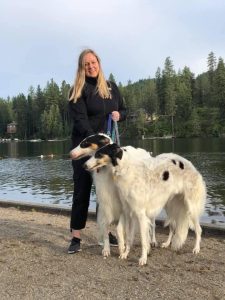 “I think the Russian Wolfhound, it’s a bit of a misnomer,” Terra, president of the International Borzoi Council, said. “Because, actually, the breed in its native land used to hunt many things other than Wolves, but Wolves also. So they were initially bred as a typical sight hound that would hunt the European hare, kind of like a jackrabbit. They’re big in the Russian steppes and the big open spaces but also the forest meadows. So those sighthounds initially had to have a lot of speed on short distances.”
“I think the Russian Wolfhound, it’s a bit of a misnomer,” Terra, president of the International Borzoi Council, said. “Because, actually, the breed in its native land used to hunt many things other than Wolves, but Wolves also. So they were initially bred as a typical sight hound that would hunt the European hare, kind of like a jackrabbit. They’re big in the Russian steppes and the big open spaces but also the forest meadows. So those sighthounds initially had to have a lot of speed on short distances.”
Terra, along with her mother, moved from St. Petersburg, Russia to the United States and acquired their first Borzoi in 1993.
“The first depiction of a Russian wolfhound, Borzoi, is actually at the Saint Sophia cathedral in Kiev, Ukraine,” Terra noted. “It’s one of the frescoes. Since Sophia cathedral dates back to 1037, that is one of the first depictions (of the breed) And also in the illuminated Chronicles of a couple of centuries later, there’s another beautiful depiction of one of the czars hunting with Borzoi. So that’s kind of the second depiction of the breed.
“So the breed goes back ancient and it has changed over the years. Different breeds have been added to it. As the country changed both geographically, you know the forests were cleared, so more stamina was required of a sighthound, the breed changed. Also as the country changed politically, for instance when the serfdom was abolished, when the big aristocratic families of Russia could no longer take care of big kennels, then the breed changed again. But it has always been the symbol of that country and just the epitome of an elegant, yet powerful creature.
“The Royal family is always the one that draws the most attention and just kind of nostalgia, and these beautiful tales and palaces. Of course the Russian czars, they had their own hunt it was the Imperial hunt and it was in the suburb of Saint Petersburg. But one of the biggest breeders and the most famous kennels of the time was actually the czar’s uncle.
“But that was just the czar’s family. There were many Noble families across this vast country and they all considered it their duty to have their own line of beautiful Borzoi and they all competed against each other in how beautiful their Borzoi were, and how fast and agile they were, and how many Foxes or hare or Wolf they could catch.
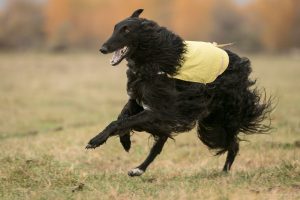 “They would have many kind of field trials, where different neighboring land owners would get together with their dogs and just compare them. The very first written description of the breed appeared in an article in a hunting magazine in 1888. That description was voted on by the Imperial hunting society members. They all voted on that and I suppose that could be called the first standard of the breed.”
“They would have many kind of field trials, where different neighboring land owners would get together with their dogs and just compare them. The very first written description of the breed appeared in an article in a hunting magazine in 1888. That description was voted on by the Imperial hunting society members. They all voted on that and I suppose that could be called the first standard of the breed.”
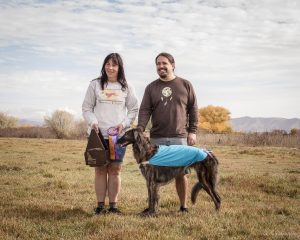 Miller added, “a lot of them (breeders) wrote their own standards, which was interesting. There was one (that was) like ‘oh the black and tan ones are the best’ and then this other guy that lived over the other ways like ‘Oh no, tan markings is bad.”
Miller added, “a lot of them (breeders) wrote their own standards, which was interesting. There was one (that was) like ‘oh the black and tan ones are the best’ and then this other guy that lived over the other ways like ‘Oh no, tan markings is bad.”
465 – Allison On: Tips from the Top on Drop Coat Grooming
Allison On: Tips from the Top on Drop Coat Grooming
Allison Alexander, founder of Leading Edge Dog Show Academy and President of the Canadian Professional Handlers Association, joins host Laura Reeves to talk about grooming drop coated breeds, from maintenance to polish.
Allison’s years of experience provide enormous insight into the maintenance on coated breeds from a Maltese to a Briard. Along with professional tips on the tools of the trade…. What kind of pin brush, what type of wraps, HOW to wrap and band. We cover it all right here. Read on for just the tip of the iceberg. And click to listen to the entire fabulous conversation.
“Obviously the basics start with line brushing,” Allison said. “And one thing I will say about drop coats, and people might disagree with me, but drop coats more than any other coat type, you can’t have a bad day.
“Even a poodle in full show coat, you can skip a bath. They could get wet in a rainstorm or snowstorm and it’s midnight and you’ve driven for two days to get home and, I’m not recommending it, but you can let them get away with like towel him dry, sleeping it off overnight and starting the next day. You have a long coat, especially as single-coated long coat, and you do not have those options.
“So the commitment is like times 10 to me. There are no days off. So when it comes to line brushing to me to keep a really fully coated drop coat breed in coat, line brushing has to be something that you’re doing every day. You’re going to change those wraps every day. You’re going to change that topknot every day. You’re going to make sure that they look perfect.
“When it comes to line brushing, my kind of general rule of thumb is, the longer the coat the more coat they have, the longer the pin in the pin brush. When it comes to a single-coated drop coat, I’m going to use a brush with a slightly softer pad firmness. The double-coated drop coats, I’m going to use a brush that has a slightly firmer pad that the pins go in.
“We also know that no matter what we’re brushing, but again more important for long coats, never, ever brush the coat dry. You need some kind of brushing spray, whether it’s a brushing spray that’s just cutting down on static, whether it’s one that’s adding some kind of conditioner to the coat or whether it’s a detangling brushing spray. But they cannot be brushed dry. You’ll just keep snapping those ends off.
“When I am line brushing, I like to teach my dog to lay down on their side. Especially a drop coat because obviously, with that longer outer coat hanging down, you’re not going to get underneath. So if you’re drop coated dog is standing up, even if it’s a Skye terrier, even if it’s a Briard, how are you going to hold all of that coat up out of your way. You’re not going to be able to do that. So the first thing you can do is teach your dog to lay down on the table.
“Remember that our grooming tables are fabulous, they have non slip surfaces, but they are not the thing that our dog really wants to lay on. When I’m laying my dogs down to be line brushed, they typically have maybe a yoga mat, a grooming mat or like a thin dog bed, at the very least a nice thick bath towel underneath them. Mine typically have some kind of grooming mat and then a nice thick bath towel underneath them so that they’re comfortable. ‘Cause you’re going to be here for awhile.
“You’re going to start at the very shortest hair like as far down on the belly as you can and then I like to take the sections when I’m line brushing… so line brushing actually means going line by line through the coat… you have to create those lines. So, you’re creating those lines, typically you could use a knitting needle. I like to use a plastic rat tail comb. Some people use a metal rat tail comb, some people get really good at using their fingers.
“I like to go about a finger width between each line ’cause sometimes people are lined brushing but they’re using like 3 inches of code at a time and wondering why they’re not getting the same results so a fingers width. Obviously like on a little dog like a Maltese it probably would be my little finger and probably on a bigger dog like a Skye terrier, a Briard, it would be like a bigger finger.
“You’re going to take a layer coat, you’re going to mist it with whatever your brushing spray is, brush it with your pin brush, check it with your comb. We’re not using our comb to groom the dog because otherwise you’re going to be removing too much coat. We’re using the comb to check that we did get all the way down to the skin from one end of that line that we did (to the other.)
“Typically I’m going to go from the belly to the top line. Then I’m going to do each leg in the same manner. I don’t typically do the legs or the tail or the neck at the same time. I go from the armpit to the loin area all the way up from the belly. Then I’m going to the front leg from the bottom of the foot up. Back leg, under the tail, the tail, then the neck. It’s in sections. An it’s line by line by line.”
464 – Autoimmune Disorders: Thyroid Disease
Autoimmune Disorders: Thyroid Disease
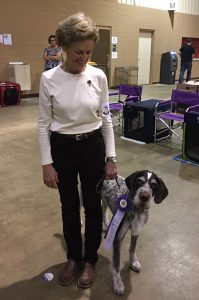
Dr. Robin Nelson, DVM and her GWP, Outlaw, CH/VC Scotian Tougher than Leather, JH, UDX.
Dr. Robin Nelson, DVM joins host Laura Reeves for a deep dive into the impacts of autoimmune mediated thyroiditis, both on individual animals and on breeding programs in general.
“The thyroid gland is a little gland on either side of the windpipe in all dogs,” Nelson said. “It is behind metabolism, so it affects nerves, organs, the brain… it is in charge of a lot of things, so presentation can vary. When I first graduated (Iowa State University, College of Veterinary Medicine), if you didn’t have a morbidly obese patient, thyroid didn’t cross your mind. It just wasn’t a concern.
“Certainly, obesity or weight gain without an explanation, without caloric intake increase (is a symptom) but even alopecia across the nose, unexplained lameness, chronic skin conditions, chronic ear conditions, vestibular disease… the list is long. Seizures, I mean if we have a dog with seizures (in the clinic), we look at thyroid function.
“The important piece of the equation, when we’re talking about thyroid, is how many different bodily systems it impacts … if your gut feeling is — ‘I’ve treated my dog skin appropriately or I’m not feeding my dog that much food that it should be overweight or here’s my dog that has loved to train, its young still, why is it all of a sudden selecting to sleep in the sunshine not firing up to do its job’ — those are all subtle (clues)… thyroid disease can also mimic all sorts of medical conditions, so trying to confirm that it’s thyroid disease is a whole ‘nother process.
“I just think if we don’t look for it, we don’t see it. It is common. As a practicing veterinarian, it is out there. There’s nothing better than diagnosing it and having your patient respond because it is so treatable and the majority of the symptoms disappear with synthetic thyroid hormone (which is) inexpensive.
“(Owners should) look for a lab that actively searches for the different numbers that you need to confirm a diagnosis. You need to make sure that the free T4 is measured by equilibrium dialysis that will allow that number not to be affected by medication, not to be affected by most other systemic disorders.
“Just as a veterinarian, I worry more about the numbers of people that don’t test at all. There are a lot of breeds with thyroid disease. I will tell you that there’s even a range, for me, looking at equivocal… I have told people, if you have an equivocal profile and everything else about your dog is so fantastic you can’t hardly stand to think that it won’t be in the gene pool, then minimally you need to really do a lot of vertical and horizontal pedigree research on both sides of the pedigree.
“There are lots of equivocals that go on to produce and I think there are lots of people who have equivocals that everything else is looking good, they just breed. But at some point, equivocal can turn into autoimmune mediated thyroiditis.
“Hypothyroidism is a process that occurs over years. A dog is not hypothyroid until about 70% of its thyroid gland is destroyed. So, you have a list of numbers that you’ve used to assess thyroid function and it’s such a gradual process … Technically, people should be testing dogs in a breeding program annually, not just taking the two year old result.”
For additional insight on thyroid disease, listen to Dr. Jean Dodds here.
463 — 4H and All-American Dogs Competing in Juniors
462 – Talk ON! Juniors and Canine Partners
Talk ON! Juniors and Canine Partners
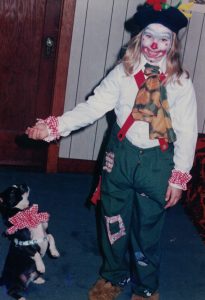 As part of Pure Dog Talk’s commitment to engaging conversations, modeling appropriate dialogue and encouraging thoughtful discussion, we are bringing you two sides of the currently white-hot topic in the dog world: AKC’s pilot program to allow junior handlers to exhibit Canine Partners in Junior Showmanship classes.
As part of Pure Dog Talk’s commitment to engaging conversations, modeling appropriate dialogue and encouraging thoughtful discussion, we are bringing you two sides of the currently white-hot topic in the dog world: AKC’s pilot program to allow junior handlers to exhibit Canine Partners in Junior Showmanship classes.
From Dog News:
At its January meeting, the American Kennel Club board of directors green-lighted a proposal from the Delegate Junior Sub-Committee and AKC staff to allow non-purebreds to be exhibited in Junior Showmanship.
The AKC pilot program is modeled after the rules used in 4-H, where mixed breeds are permitted. In order to compete, dogs must have an AKC Canine Partner number and meet the ownership eligibility criteria. Juniors will indicate the breed that the dog is being exhibited as on the entry form. So, for example, a dog entered as a Golden Retriever mix would be presented in the same way as a purebred Golden.
The rationale for allowing mixed breeds in Junior Showmanship is to provide an opportunity for a wider range of youngsters to participate in the sport of dogs, and give them an opportunity to learn, practice and improve their handling skills, as well as find mentors.
This pilot program will go into effect on July 1, 2021, and continue for 18 months before it is assessed in 2022. It is limited to all-breed shows or events holding all-breed Juniors.
Predictably, this topic has engendered heated discussion amongst the children and adults who populate this arena. Sadly, many of those conversations have devolved into the 21st century curse of ugly discourse.
As an antidote to this, we’re bringing you two weeks of conversation, devil’s advocate positions and insight from two perspectives in this debate. Listeners may or may not agree with one “side” or the other. But I firmly believe that until we *hear* one another, we can’t make progress … in anything.
Feel free to share your thoughts on the Pure Dog Talk FB page, or here in the comments. But rest assured, ANY ugliness, name calling or other inappropriate behavior will not be tolerated. Be passionate AND polite.
Today, Jody Davidson, long time Juniors coach and advocate, along with Bevin Towell, junior showmanship exhibitor, join host and moderator Laura Reeves to make the case for their position.
Next week we are joined by 4H leader and advocate Sarah Gardner for the “rebuttal.”
As always, talk ON!
461 — Genetic Ancestry – Deep Dive on Genetic Testing
Genetic Ancestry – Deep Dive on Genetic Testing
Aaron Sams, the principal scientist at Embark, joins host Laura Reeves to take us through the algorithms and data sets that create the genetic codes for each purebred dog breed.
“Dog population and dog evolutionary history is really complex,” Sams noted. “There’s a lot of dogs in the world and most of them are what we call village dogs. They are just free-breeding free-ranging dogs that live with human populations … then you have some of these ancient breeds … salukis and other what I think of as landrace breeds, these are dogs that are living with humans, they are purpose bred, they’re adapted to the region in which they live… Then you’ve got the purebred dog breeds that we are most familiar with in Europe and America.
“A registration organization decides these are the standards, this is what this dog has to conform to to be a registered purebred of this breed. But genetic variation is a lot more complex. Within each of those breeds, there are genetic variation across those dogs. They’re not clones of each other. They’re not genetically identical. A lot of breeds are related to each other.
“So it’s all pretty complex. How do you do ancestry testing and decide, given some random dog, what ancestry is the best fit for that dog? What’s our best estimate of the ancestry of that dog? So rather than thinking of it from a single reference genome, we have to think about it as a population. We have a reference database with large numbers of individuals that serve as references for that given population.
“What we’re trying to do is capture as much of that genetic diversity that represents that population as we can, so that anytime we take a new dog and we compare it to those reference individuals we can see that this dog shares DNA that’s very, very similar to those reference individuals.
“There’s different levels of genetic diversity in each of these populations. If you have a very inbred breed that doesn’t have very much genetic diversity, you might need a smaller number of individuals to capture the genetic diversity for that entire population. The more individuals you add to your reference, the more accurate you’re going to get, the more you can match those individuals that you’re testing identically.
“Let’s say you send one of your dogs in and we say it’s around 90% German wirehaired pointer and 10% English pointer … that happens. Those are very closely related breeds. Sometimes you have lineages of that breed that we don’t have in our reference database. So sometimes you’ll see that kind of thing happen. But a year later, you come back and we’ve added more registered German wirehaired pointers. Now we have dogs in our reference data set that are actually better matched for that DNA … Over time these things are going to change.
“If you take a frozen semen sample from several generations ago, say 5-6 generations in the past, then you bring that forward and you breed a dog with that frozen semen sample. If there was more outcrossing or the breed was still kind of information (when that dog was alive), there’s definitely a good chance that if we now have a very well-established reference data set for that breed, that you bring that genetic diversity forward, it may not actually be present in most dogs in that breed today. Now you’ve got ancestry or DNA from earlier in the population that’s maybe been lost over time and you’re reproducing it … if we don’t have that in our reference data set for that breed it’s going to be called as something else….”
For more on this absolutely fascinating deep dive on genetic ancestry DNA testing, listen to the podcast episode above.


